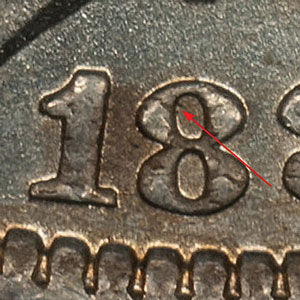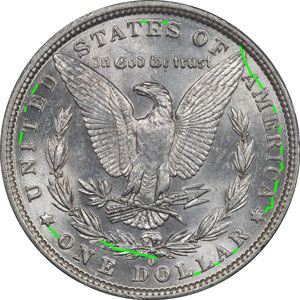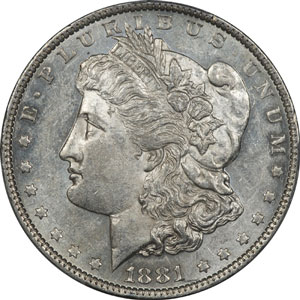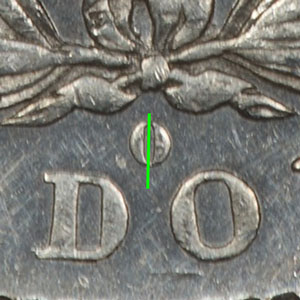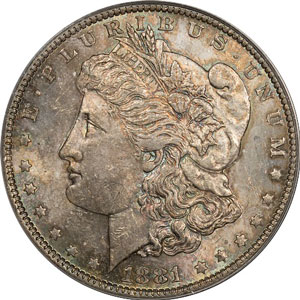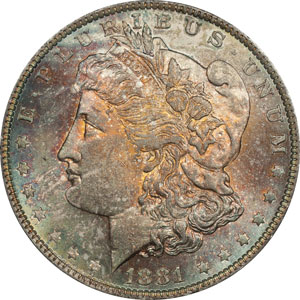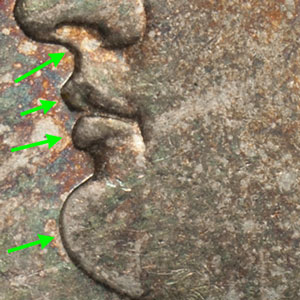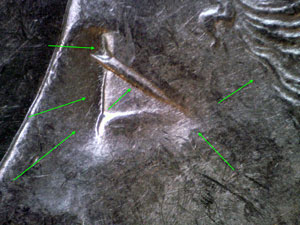
February 2022 - Welcome
Sources
Search
Contact
Home
Welcome
Click on year to expand
2022
2021
2020
2019
2018
2017
2016
2015
Welcome
Antebellum Mint Supervisors
Confederate New Orleans
![]() Feedback From Leroy
Feedback From Leroy
I posed a number of questions to Leroy last month and he was kind enough to pass along some timely information and his thoughts about VAMs 1 and 1A.
However, VAM 1 may hold the distinction for not just the 1881-O series, but for all, of being a state that does not exist. In other words, if we assume the VAM 1 to be an "As intended" state it would be possible for no coins to be struck on perfect dies. It is also possible, I assume, that even if struck these may never surface.
Since many dies were touched up, repaired, and/or repolished by the engravers and die sinkers it is possible, maybe even probable that these don't exist in most cases.
VAM 1A was the sixth VAM recognized for the 1881-O series. Discovered by Leonard Hinckley. For sure VAM 1A exists because the feature of "Spike in the First 8" repeats in many VAMs and I believe would point to this physical die or hub as the progenitor of many other VAMs.
It is with this backdrop that I started looking into our examples of VAMs 1 and 1A.
![]() VAMs 77 and 77A
VAMs 77 and 77A
After the newsletter last month I pull the coins that had been identified as VAMs 77 and 77A. It seems obvious after examination that these are in fact VAM 68 examples and therefore we have retired 77 and 77A.
![]() New VAMs, We Think
New VAMs, We Think
Our detailed look at all of our VAM 1 and 1A coins produced some interesting results. We think we have identified four new VAMs that for now we will label A through D. (Click on the title to go to the discussion of each set of coins.
- Doubled BER, Doubled Date, Spike in 8, Pitted Wing-Neck Gap
- Same Reverse as Type A; No Spike in 8, Doubled 18, Notched Right 1
- Buck Tooth, Dot in Left Leaves
- Double Profile, Polish Lines in Front of Eye, O Tilted Right, Die Chip Wing-Neck Gap
![]()
Now that a great deal of the die fingerprint work is behind me I plan to return to the study of the Mint Supervisors in New Orleans. We stopped this study with the onset of the Civil War, so time to get back to that look into time.
1837 - 1839 David M. Bradford
1839 - 1850 Joseph M. Kennedy
1850 - 1852 Robert M. McAlpin
1853 - 1857 Charles F. Bienvenu
1857 - 1861 William Augustus Elmore
After last month's newsletter we did more investigation into the transition of the Mint from the United States to the Confederacy. Of particular help were three video lectures warehoused at the Newman Numismatic Portal.
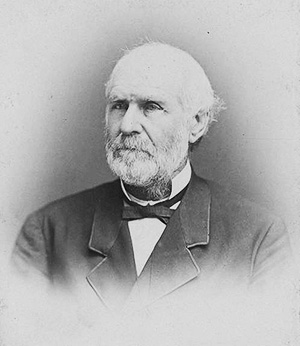
William Augustus Elmore
To understand the transition one really needs to listen to all three lectures and distill what you learned into your own interpretation. The conclusion I drew last month that William Elmore had resigned was incorrect and he continued on as the Supervisor of the Mint under CSA control. Apparently Mint employees were required to take a loyalty oath to the Confederacy and/or State of Louisiana to continue on in their jobs, and most did.
To understand how these events played out a time line of the events helps.
![]()
The port at New Orleans was critical to both the North and South because controlling it meant control of the Mississippi River. Confederate control of New Orleans was short lived, so obviously Mint events were compressed into a narrow window.
- January 26, 1861 Secession from the US
- January 29, 1861 Federal employees given the option to continue in their posts as Louisiana State employees
- February 1, 1861 an inventory of assets ordered and found $308,771 in gold coins and $175,212.08 in silver coins
- April 1861 last coins minted as bullion ran out, these included a small number of Confederate half dollars, of which only four are known
- May 31, 1861 the last employees leave the Mint and it then became quartering for CSA troops
- Late 1861 Four Confederate half dollars struck
- January 1862 start of the Federal blockade of the port
- April 18, 1862 US ships start shelling Forts Jackson and St. Philip
- April 25, 1862 William B. Mumford and a few other southern sympathizers remove the US flag from the Mint building
- April 28, 1862 Forts Jackson and St. Philip surrender and US Flag raised over the Mint
- May 15, 1862 General Butler's famous order number 28 labeling outspoken women as prostitutes
- May 30, 1862 William B. Mumford found guilty of treason for the flag incident
- June 7, 1862 William B. Mumford hanged at the Mint
- The Mint stayed closed from the end of the war until 1876 when it was reopened as an Assay Office.
- 1880 The Mint begins production again with Morgan Dollars
![]()
VAMs 1 and 1A Analysis
VAMs 1 and 1A
VAM 1 - Normal Dies
VAM 1A - Spike in 8
We have not classified any coins as VAM 1 or 1A in years and I think for good reason. These were early in this project and what seemed like featureless coins at the time have now received classifications as later discoveries.
But as we dig into the analysis not all coins fall neatly into a new or different classification as an existing VAM. For sure many of the coins have Reverse Die d not a, just in a different die state than other identifiable VAMs. But the Obverse Dies vary, or seem to at this stage. Our die crack analysis is proving to be a great shortcut to the identification of these dies.
Rather than jumping into this with conclusions we took the month of February to look at the fifteen VAM 1 and five VAM 1A coins in more detail and report back here with some conclusions. This was a coin by coin analysis and there is a discovery or two (or three, or four) buried within these groups.
![]()
VAM 1 coins should be featureless and "as intended" by George Morgan. These must be reviewed one coin at a time to sort out the then versus now conclusions.
Just for classification we will designate them as A, B, C, etc.
Our conclusion at the end of this analysis is there are no VAM 1 coins in our collection, and perhaps no VAM 1 coins exist.
![]()
VAM 1 for the 1881-O series, and we believe for all series may only be a theoretical VAM. It could exist, but given the level of technology at the time it seems unlikely that perfect coins could have been struck. Like VAM 1A it could exist, but it would have to be paired with a like perfect reverse die, and this is unlikely.
All 1881-O coins either have the die chip in the first 8 or they do not.
![]()
VAM 1A coins should be featureless and "as intended" by George Morgan except for the spike in the upper loop of the first 8. These must be reviewed one coin at a time to sort out the then versus now conclusions.
Just for classification we will designate them as A, B, C, etc., and when the dies match those previously classified as VAM 1 we added them to that list.
Our conclusion at the end of this analysis is there are no VAM 1A coins in our collection, and perhaps no VAM 1A coins exist.
![]()
VAM 1A also may not exist, partially for the reason VAM 1 may not exist. But VAM 1A is much more likely to be fictional because it is the progenitor of any VAM with a secondary obverse or reverse die pairing. The die may exist, but the die pairing is highly unlikely.
![]()
Details
PCGS 80641486
Other Coins Fitting
All images can be enlarged by clicking on them.
Obverse
Doubling of the BER of LIBERTY
Some date doubling with a little crud in the corner of the first 1 flag
Small spike in the first 8 that can be pronounced or just forming
Slight doubling of the first 8 and maybe a little doubling of the second 8
Slight "crud" in the corner of the first 8 at the flag junction
Reverse
Die cracks that go around the coin near the rim on the reverse
Some slight field displacement on the reverse
Pitting in the wing neck gap and in the wing below the gap similar to the discovery coin for the new VAM 79, but a different pattern on close inspection. But looking at the reverse of our Type B in this discussion we can identify this as Reverse Die d, the same as VAM 68.
We now know that the difference in the pitting pattern is die state and not a separate die.
![]()
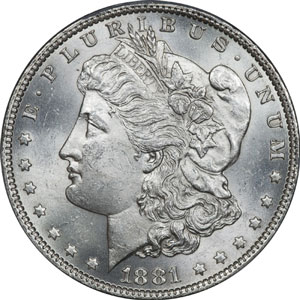
PCGS 80641486 has some of the characteristics of VAM 68, but lacks a lot of the minor die cracks. The die rust in the eagle's left wing and the wing gap is there.
There is a small die chip in the left 8, but it is not pronounced, but still large enough that this probably should have been in the 1A group. The BER in LIBERTY is doubled. We would say that the date shows some doubling on all numerals. The distinguishing feature is doubling under the flag of the right 1.
![]()
PCGS 81168198
PCGS 81168198 is somewhat difficult to evaluate because of the excessive toning. However, the doubled BER on the obverse is the same as on 80641486, so this is the same physical obverse die. The right 1 does not have the same doubling at the flag, making me think that the doubling is from strike and not on the die.
The reverse die is a little further along and the die cracks are more visible.
![]()
With these two coins forming a pattern I examined the remaining VAM 1 and VAM 1A classified coins to find others. Fitting this pattern are:
84368549 AU 55
08187979 MS 62
29426558 MS 62
20141046 MS 63
31698467 MS 63
33025132 MS 63
80467523 MS 63
84145172 MS63
07903010 MS64
26309096 MS 64
![]()
PCGS 27696884
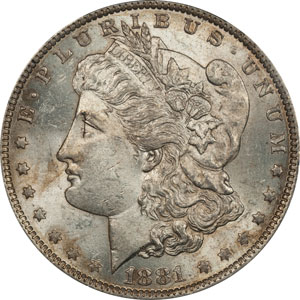
Classified as a VAM 1A, PCGS 27696884 is a favorite because it is like no other in our collection. The Spike in 8 is hard to see, but there. The doubled BER is there and easier to confirm. On the reverse the pitted left wing and neck gap are very obvious as the die continued to deteriorate.
But the real distinguishing feature of this coin is this has to be the final die state. The coin is heavily pockmarked on both sides with deterioration like we have seen on no other coin in the collection.
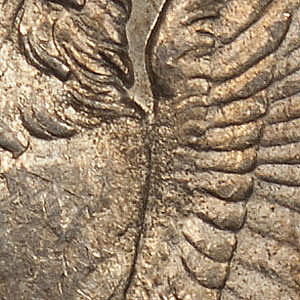
And still this is in fact a Mint State 62 coin.
![]()
Details
PCGS 32125853
All images can be enlarged by clicking on them.
Obverse
Doubling of 18 but no signs of doubling on the right 1, but the right 1 is notched
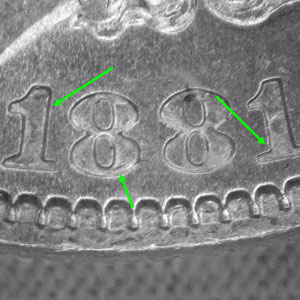
Reverse
The same die cracks around the perimeter of the coin as Type A
Same pitting at the eagle's left wing and the wing neck gap
The same displaced field at the top toward the rim
A big difference is that these die cracks now extend into the area above the mint mark. But this is a different pattern than VAMs 2A, 40.1, 40.2, 47, and 53.
But this is the same pattern as VAM 68, so on both Type A & B in this discussion we can identify this coin as having a Reverse Die d.
![]()
PCGS 32125853 has the same characteristics discussed above and to the left.
There is no die chip in the left 8, which is a distinguishing characteristic from the Type A group above.
![]()
PCGS 82490320
PCGS 82490320 has none of the same characteristics discussed above with other coins.
There is no die chip in the left 8, which is a distinguishing characteristic from the Type A group above. Also distinguishing this coin is a bar in the mouth that almost looks like a front tooth. I have seen this on another die, but my search did not turn it up and that will take more research.
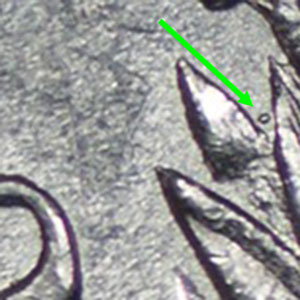
This example has the reflectivity of a PL or DMPL coin, so there are no die cracks to help with the identification. The mint mark appears to me to be upright and the only distinguishing characteristic I can find is a small dot in the left leaves beside "U".
![]()
PCGS 80467522
PCGS 05501477
PCGS 28502822
PCGS 80467522 has none of the same characteristics discussed above with other coins. It proved to be one of three coins fitting this description. It is not VAM 8 with the O Tilted Right definition. This is an AU 58 coin but retains a lot of the reflectivity of a PL or DMPL coin.
There is a die chip in the left 8, which is a distinguishing characteristic. But the real differentiation is a set of polish lines in front of the eye, but not easily photographed in this coin. There is also some profile doubling from the nose through the lips, but this is not visible below MS 61 in our examples.
There are no die cracks to help with the identification. The mint mark is tilted right, but this is not VAM 8.
Also as an identification there is a die scratch or chip in the wing-neck gap.
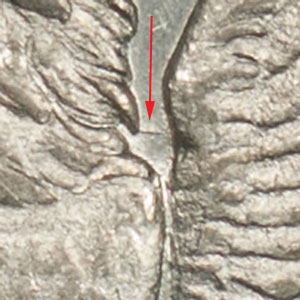
![]()
PCGS 05501477 has the same PUPs as the other coins in this VAM series.
There are a lot of die polish lines, but they are not deep and do not photograph on this toned coin.
This is an MS 61 example.
![]()
PCGS 28502822 has the same PUPs as the other coins in this VAM series.
There are a lot of die polish lines at the eye, but they are not deep and do not photograph well on any of the coins.
This is an MS 62 example.
![]()
Other Coins
PCGS 02336918
PCGS 02336918 was just not attributed correctly and is a VAM 8 - O Tilted Right
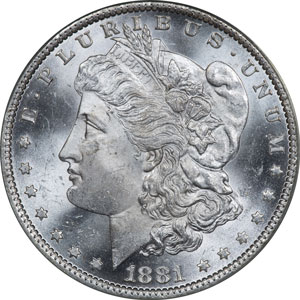


There is a photography illusion in this image and the mint mark is not doubled. Other slight anomalies on the coin confirm this as a VAM 8.
![]()
Getting Started
Collecting The 1881-O
The 1881-O VAMs


























